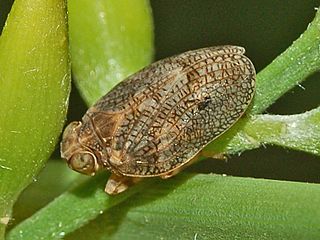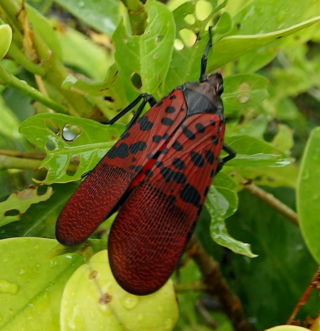
The family Fulgoridae is a large group of hemipteran insects, especially abundant and diverse in the tropics, containing over 125 genera worldwide. They are mostly of moderate to large size, many with a superficial resemblance to Lepidoptera due to their brilliant and varied coloration. Various genera and species are sometimes referred to as lanternflies or lanthorn flies.

A planthopper is any insect in the infraorder Fulgoromorpha, in the suborder Auchenorrhyncha, a group exceeding 12,500 described species worldwide. The name comes from their remarkable resemblance to leaves and other plants of their environment and that they often "hop" for quick transportation in a similar way to that of grasshoppers. However, planthoppers generally walk very slowly. Distributed worldwide, all members of this group are plant-feeders, though few are considered pests. Fulgoromorphs are most reliably distinguished from the other Auchenorrhyncha by two features; the bifurcate (Y-shaped) anal vein in the forewing, and the thickened, three-segmented antennae, with a generally round or egg-shaped second segment (pedicel) that bears a fine filamentous arista.

Flatidae are a family of fulgoroid planthoppers. They are cosmopolitan in distribution and are distinguished from others in the superfamily by a combination of characters. Like all other planthoppers, they suck phloem sap of plants. Some species are known to communicate with vibrations through the plant stems. Communication may be with mates, or with ants that tend the nymphs, protecting them and gathering honeydew secretions. Adults of some species have brightly coloured forewings which are tougher and known as tegmina unlike the membranous hindwings which are used for flight. Although a few can be identified by their coloration, most species requires dissection and examination under a microscope with access to literature on already described species.

Enchophora sanguinea is a species of lantern bug, a type of hemipteran, found in Central and South America. It was first described by William Lucas Distant in 1887. They are 25 millimetres (1.0 in) long. Their colour varies, but is normally red to green; they have a scimitar-shaped process on their heads. They feed on the sap of trees, most commonly Simarouba amara, and they excrete honeydew out of their anuses.
Glisachaemus is an extinct monotypic genus of planthopper in the Cixiidae subfamily Cixiinae and at present, it contains the single species Glisachaemus jonasdamzeni. The genus is solely known from the Early Eocene Baltic amber deposits in the Baltic Sea region of Europe.

Issidae is a family of planthoppers described by Spinola in 1839, belonging to the order Hemiptera, suborder Auchenorrhyncha superfamily Fulgoroidea.

Issus is a genus of planthoppers belonging to the family Issidae of infraorder Fulgoromorpha of suborder Auchenorrhyncha of order Hemiptera. Like most members of the order Hemiptera they live on phloem sap that they extract with their piercing, sucking mouth parts.

Ordralfabetix is an extinct genus of planthoppers in the family Lophopidae and containing the single species Ordralfabetix sirophatanis. The species is known only from the Early Eocene, Ypresian stage Oise amber from the Quesnoy locality, Oise Department, France.

Nogodinidae is a family of planthoppers. They have membranous wings with delicate venation and can be confused with members of other Fulgoroid families such as the Issidae and Tropiduchidae. Some authors treat it as a subfamily of the Issidae.

Issus coleoptratus is a species of planthopper belonging to the family Issidae.

Acropyga glaesaria is an extinct species of ant in the subfamily Formicinae known from a group of possibly Miocene fossils found on Hispaniola. A. glaesaria is the first species of the ant genus Acropyga to have been described from fossils found in Dominican amber and is the one of several species of Acropyga found in the West Indies. As with other members of the genus, A. glaesaria was most likely trophobiotic.

Neoptychodes trilineatus is a species of flat-faced longhorn beetles in the subfamily Lamiinae.

Anochetus exstinctus is an extinct species of ant in the subfamily Ponerinae known from two possibly Miocene fossils found on Hispaniola. A. exstinctus is one of eight species in the ant genus Anochetus to have been described from fossils found in Dominican amber and is one of a number of Anochetus species found in the Greater Antillies.

Anochetus lucidus is an extinct species of ant in the subfamily Ponerinae known from two possibly Miocene fossils found on Hispaniola. A. lucidus is one of eight species in the ant genus Anochetus to have been described from fossils found in Dominican amber and is one of a number of Anochetus species found in the Greater Antillies.

Myrmecia regularis is a species of ant endemic to Australia. A member of the genus Myrmecia in the subfamily Myrmeciinae, it was first described by American entomologist Walter Cecil Crawley in 1925. These ants are medium to large in size, measuring 10 to 20 millimetres, and they are bright brownish-red in colour. Queens and workers share similar morphological features, but they can be distinguished by the noticeable size difference. Males also look similar, but collected specimens are too damaged to be examined properly.

Bythopsyrna circulata is a species of Asian planthoppers belonging to the family Flatidae.

Distoleon tetragrammicus is a species of antlion in the subfamily Myrmeleontinae.

Agalmatium is a genus of planthoppers belonging to the family Issidae, subfamily Hysteropterinae.

Dundubia is a genus of cicadas in the subfamily Cicadinae and the type genus of the tribe Dundubiini.

Lycorma meliae is a planthopper species endemic to Taiwan, with multiple, dramatically different color morphs depending on the life stage. The species was described by Masayo Kato in Taiwan in 1929, and is the only member of its genus confirmed to be native to the island. In 1929, a specimen of L. meliae was originally described as a separate species, L. olivacea, also by Kato. These two taxon names were declared synonymous in 2023. L. meliae undergoes four instar stages before achieving adulthood and generally only survive until the winter.

















